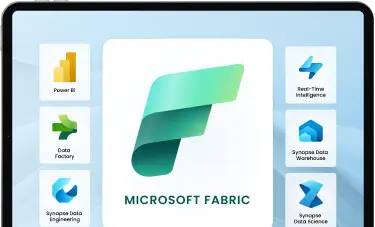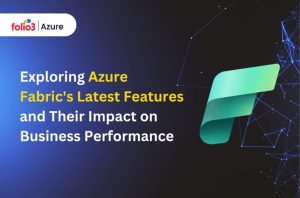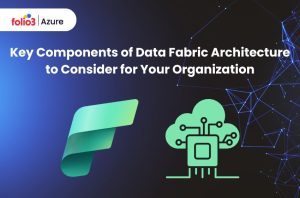Table of Contents
ToggleToday, businesses can leverage Microsoft Fabric’s robust data integration, analytics, and storage capabilities thanks to its flexible pricing approach, tailored to meet diverse business needs.
Companies must thoroughly understand Microsoft Fabric’s pricing model to maximize the company’s broad information platform while keeping costs low.
This article covers the details of Microsoft Fabric’s pricing system, guiding you through the available choices and assisting you in selecting the one that best suits your needs.
Accelerate smart decisions with Microsoft Fabric's unified data and AI analytics.

Microsoft Fabric Pricing Models Options
Microsoft Fabric provides several pricing structures to accommodate different usage patterns and business objectives. The primary options are Pay-As-You-Go and Reserved Instance Pricing (Capacity-Reservation Model).
1. Pay-As-You-Go
The Pay-As-You-Go model is ideal for organizations with varying usage patterns or those starting small and scaling up as needed. This flexible pricing model allows businesses to pay only for the resources they consume without any upfront commitment.
Resource Type | Price Per Unit |
| Compute (vCore/hour) | $0.50 |
Storage (BG/month) | $0.02 |
| Data Processing (TB) | $10.00 |
With the Pay-As-You-Go model, businesses can continuously adjust their usage based on demand. This flexibility guarantees cost-effectiveness while maintaining performance.
Because of its flexibility, this model is a popular option among startups and small to medium-sized businesses (SMEs) having tight financial constraints.
Businesses may minimize the expenses associated with an oversupply of resources by using Pay-As-You-Go. This is especially beneficial in situations where workloads might be unexpected or seasonal.
2. Reserved Instance Pricing (Capacity-Reservation Model)
The Reserved Instance Pricing model, also known as Capacity-Reservation, was developed for businesses with predictable and steady usage patterns. This model comes with cost savings for long-term commitments.
Capacity | 1- Year reserved | 3- Year Reserved |
| One vCore | $0.40 per hour | $0.35 per hour |
1 TB Storage | $0.015 per GB per month | $0.012 per GB per month |
| Data Processing | $8.00 per TB | $7.00 per TB |
By selecting reserved capacity, businesses may lock in reduced rates and gain cost predictability, simplifying long-term budget management.
Reserved instance pricing is highly beneficial for large businesses and organizations with steady workloads that demand constant resource use.
Businesses with long-term projects and unchanging operational demands may find it a financially intelligent option. Committing to a one-year or three-year term can result in major savings.
Additional Considerations for Microsoft Fabric Cost
Additional factors should be considered when evaluating the Microsoft Fabric pricing model to ensure a comprehensive understanding of the costs involved.
Autoscaling
Microsoft Fabric’s ability to constantly modify computer resources according to workload demand is a key feature known as auto-scaling. Especially when used with the Pay-As-You-Go model, this functionality helps to maintain performance while minimizing expenses.
By preventing excessive provisioning and insufficient utilization, autoscaling ensures you only pay for the resources you actually use.
Furthermore, autoscaling promotes efficient peak-time management. For example, the system might increase resources in heavy demand to continue operating at peak efficiency. On the other hand, it might reduce resources during low demand to save money.
Data Transfer Costs
In addition to compute and storage costs, data transfer expenses should be considered, particularly for organizations that move a lot of data between multiple Azure regions or external data sources. Understanding Azure service fabric pricing will help create an accurate budget and avoid unexpected charges.
The volume and frequency of data transfers can significantly impact costs. Companies should monitor these transfers closely and consider reducing them by localizing data processing where possible.
Licensing and Compliance
Microsoft Fabric offers various licensing options to cater to different organizational needs. Businesses must choose the appropriate license based on usage, data privacy requirements, and compliance standards. Ensuring that the selected license aligns with the organization’s compliance policies is critical to avoid legal or regulatory issues.
For example, organizations in highly regulated industries like finance or healthcare must ensure that their Microsoft fabric license and usage meet specific regulatory requirements. This consideration can influence both the choice of services and the overall cost.
OneLake Storage Cost
OneLake storage, which offers safe and scalable storage options for applications requiring a lot of data, is a fundamental component of the Microsoft Fabric environment. Understanding the storage expenses is essential for preparing and developing a budget.
Storage Tier | Price per GB |
| Hot | $0.020 |
Cool | $0.015 |
| Archive | $0.005 |
OneLake storage offers tiered pricing to facilitate various data access styles. Hot storage is suitable for frequently accessed data, while Cool and Archive storage provides cost-effective options for frequently inaccessible data.
Selecting the right storage tier is a must for managing expenses. Cool storage is better suited for backup and infrequently accessed data, whereas hot storage is best for operating databases and datasets. Archive storage offers a cost-effective solution for preserving data for an extended period, including historical and compliance records.
Optimizing Microsoft Fabric Costs
To minimize Microsoft Fabric expenses, enterprises should follow these best practices:
- Monitoring and Management Tools: Azure’s monitoring and management capabilities help analyze resource usage and cost trends. These technologies facilitate quick corrections by identifying areas where resources are being over or underused.
- Resource Tagging: Use resource tagging to organize and monitor expenses related to various projects, divisions, or business units. This procedure improves accountability and cost transparency throughout the company.
- Budget Alerts and Spending Caps: In Azure, set expense limits and budget alerts to avoid unforeseen expenses. When spending approaches certain levels, these features send out early reminders so that immediate corrective measures may be taken.
- Regular Review of Reserved Instances: Examine and modify reserved instances according to changing business requirements and usage patterns. By following this procedure, the company can be sure that cost reductions will continue to be achieved while maintaining operational effectiveness.
Conclusion
Understanding the Microsoft Fabric pricing model is essential for making intelligent decisions before investing in your data management platform. Whether you choose the flexibility of Pay-As-You-Go or the cost savings of Reserved Instance Pricing, Microsoft Fabric provides a range of options for your business needs.
By carefully analyzing your usage trends and storage needs, you can manage your budget and take advantage of Microsoft Fabric’s powerful capabilities.
Choosing the suitable Microsoft Fabric pricing model can significantly impact your organization’s efficiency and goals. Assess your specific needs and consider the cost of Microsoft Fabric in terms of your long-term data strategy. By selecting the right approach, you can take advantage of Microsoft Fabric’s benefits while controlling costs.
Organizations can balance cost-efficiency and performance by selecting the right pricing model and adopting best practices. This guarantees both operational excellence and long-term success. Microsoft Fabric’s capacity pricing models set the basis for future innovation and ensure your firm remains competitive in today’s data-driven market.
The ability to customize the pricing model to meet your organization’s unique needs, whether through flexible Pay-As-You-Go options or cost-saving reserved instances, paves the way for a strategic approach to managing your IT expenditures. This method reduces expenses while enhancing the efficiency and adaptability of your data infrastructure.


